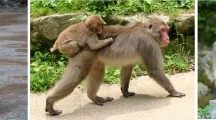Abstract
Patterns of agonistic and nonagonistic behaviors were studied in a troop of wild pig-tailed macaques in West Sumatra, Indonesia. The animals were provisioned and the identities of all adult and adolescent individuals were known. The females could be divided into high-, mid-, and low-ranking subsets of individuals. Most grooming occurred within, instead of between members of these subsets. The members of each subset also tended to feed together at the baiting sites, and they probably represented groups of close kin. Among females, grooming appeared to be a conciliatory behavior and was generally performed by the subordinate partner, while mounting was performed by the dominant partner and appeared to be a reassertion of dominance. High-ranking males tended to form agonistic alliances with females and to exchange grooming with estrous females. Low-ranking males did not have such associations with females and were frequently the targets of agonistic alliances of females and juveniles. Mounting between males appeared to be a conciliatory behavior. It seemed effective since severe aggression between males was not observed. The subordinate partner mounted more frequently than the dominant one, but the direction of mounting was apparently controlled by the latter. This suggests that, among pig-tailed macaques, the dominant male plays an important role in the coexistence of males in the troop.
Similar content being viewed by others
References
Bernstein, I. S. (1966). An investigation of the organization of pigtail monkey groups through the use of challenges.Primates 7: 471–480.
Bernstein, I. S. (1967). A field study of the pigtail monkey.Primates 8: 217–228.
Bernstein, I. S. (1969). Stability of the status hierarchy in a pigtail monkey group (Macaca nemestrina).Anim. Behav. 17: 452–458.
Bernstein, I. S., and Sharpe, L. G. (1966). Social roles in a rhesus monkey group.Behaviour 26: 91–104.
Caldecott, J. O. (1986a). Mating patterns, societies and the ecogeography of macaques.Anim. Behav. 34: 208–220.
Caldecott, J. O. (1986b).An Ecological Study and Behavioral Study of the Pig-Tailed Macaque, Contr. Primatol, Vol. 21, Karger, Basel.
Chapais, B. (1983). Dominance, relatedness and the structure of female, relationships in rhesus monkeys. In Hinde, R. A. (ed.),Primate Social Relationships, Blackwell Scientific, Oxford, pp. 208–219.
Defler, T. R. (1978). Allogrooming in two species of macaque (Macana nemestrina andMacaca radiata).Primates 19: 153–167.
de Waal, F. B. M. (1978). Exploitative and familiarity-dependent support strategies in a colony of semi-free living chimpanzees.Behaviour 66: 268–312.
de Waal, F. B. M., and Yoshihara, D. (1983). Reconciliation and redirected affection in rhesus monkeys.Behaviour 85: 224–241.
Dunbar, R. I. M. (1976). Some aspects of research design and their implications in the observational study of behaviour.Behaviour 58: 78–98.
Eisenberg, J. F., Muckenhirn, N. A., and Rudran, R. (1978). The relation between ecology and social structure in primates.Science 176: 863–874.
Fagen, R., and Mankovichi, N. J. (1980). Two-act transitions, partitioned contingency tables, and the “significant cell” problem.Anim. Behav. 28: 1017–1023.
Furuichi, T. (1984). Symmetrical patterns in non-agonistic social interactions found in unprovisioned Japanese macaques.J. Ethol. 2: 109–119.
Hanby, J. P. (1974). Male-male mounting in Japanese monkeys (Macaca fuscata).Anim. Behav. 22: 836–849.
Massey, A. (1977). Agonistic aids and kinship in a group of pigtail macaques.Behav. Ecol. Sociobiol 2: 31–40.
Oi, T. (1990). Population organization of wild pig-tailed macaques (Macaca nemestrina nemestrina) in West Sumatra.Primates 31: 15–31.
Robertson, J. M. Y. (1986).On the Evolution of Pig-Tailed Macaque Societies, Ph. D. thesis, University of Cambridge, Cambridge.
Shively, C., Clarke, S., King, N., Schapiro, S., and Mitchell, G. (1982). Patterns of sexual behavior in male macaques.Am. J. Primatol. 2: 373–384.
Simonds, P. E. (1965). The bonnet macaque in South India. In DeVore, I. (ed.),Primate Behavior, Holt Rinehart and Winston, New York, pp. 175–196.
Sneath, P. H. A., and Sokal, R. R. (1973).Numerical Taxonomy, The Principal and Practice of Numerical Classification, W. H. Freeman, San Francisco.
Takahata, Y. (1988). Dominance rank order of adult female Japanese monkeys of the Arashiyama B troop.Primate Res. 4: 19–32, (in Japanese, with English summary).
Thierry, B. (1986). A comparative study of aggression and response to aggression in three species of macaque.Proc. 10th Congr. Int. Primatol. Soc., Vol. 3, Cambridge University Press, Cambridge, pp. 307–313.
Tokuda, K., and Jensen, G. D. (1969). Determinants of dominance hierarchy in a captive group of pigtailed monkeys (Macaca nemestrina).Primates 10: 227–236.
Tokuda, K., Simons, R. C., and Jensen, G. D. (1968). Sexual behavior in a captive group of pigtailed monkeys (Macaca nemestrina).Primates 9: 283–294.
Watanabe, K. (1979). Alliance formation in a free-ranging troop of Japanese macaques.Primates 20: 459–474.
Yamada, M. (1966). Five natural troops of Japanese monkeys in Shodoshima Island. I. Distribution and social organization.Primates 7: 315–362.
Author information
Authors and Affiliations
Rights and permissions
About this article
Cite this article
Oi, T. Patterns of dominance and affiliation in wild pig-tailed macaques (Macaca nemestrina nemestrina) in West Sumatra. International Journal of Primatology 11, 339–356 (1990). https://doi.org/10.1007/BF02193005
Received:
Revised:
Issue Date:
DOI: https://doi.org/10.1007/BF02193005




